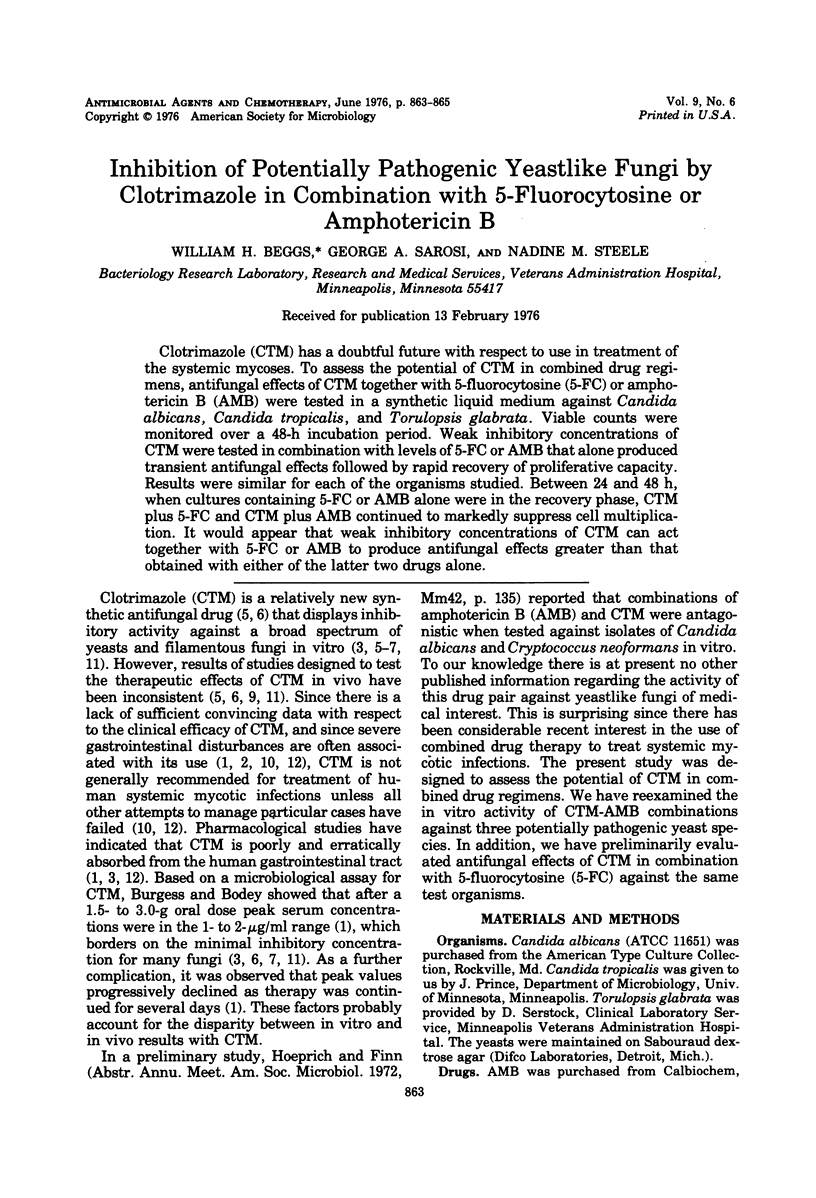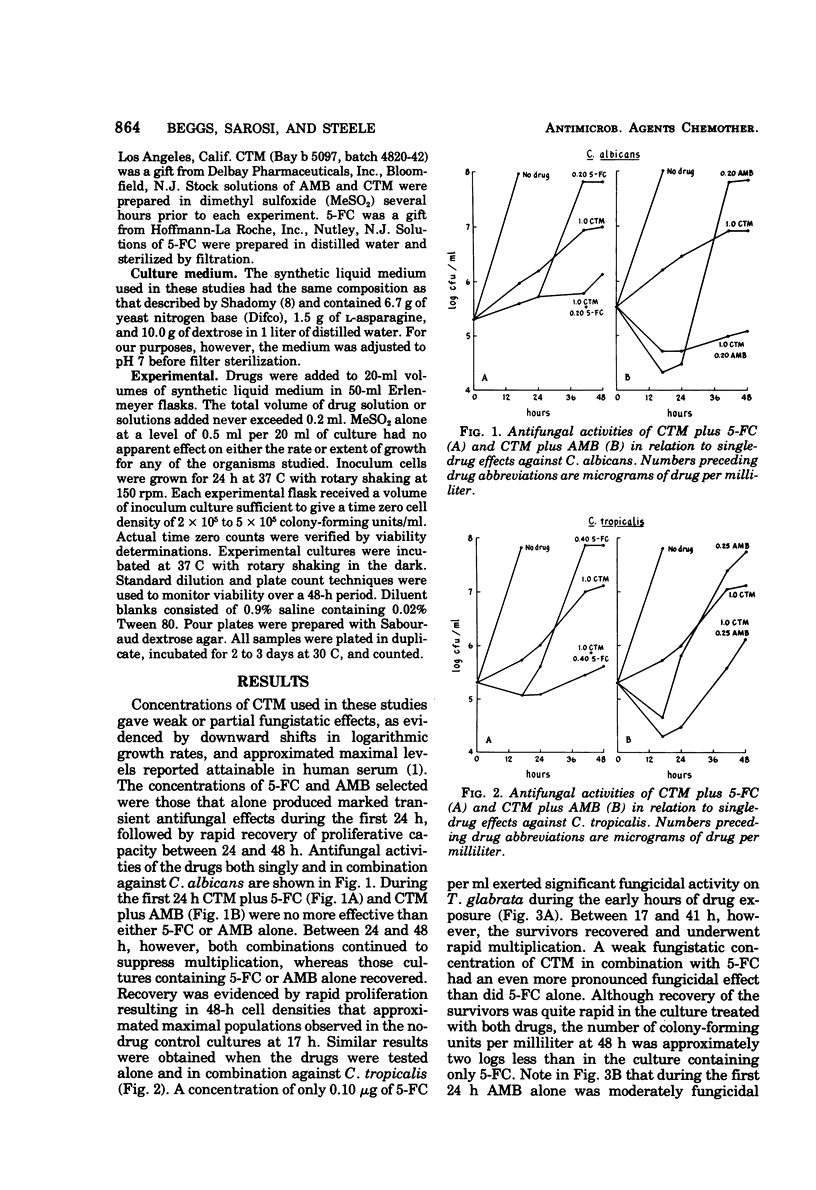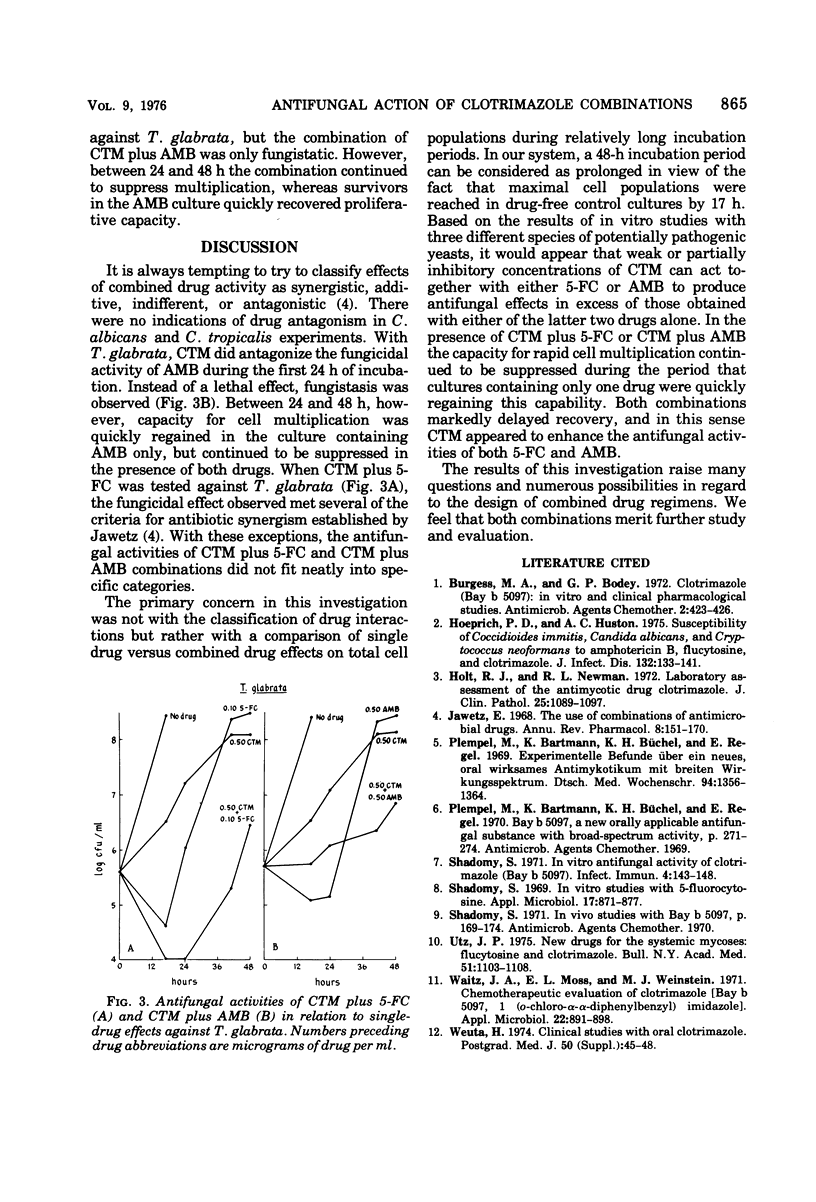Abstract
Clotrimazole (CTM) has a doubtful future with respect to use in treatment of the systemic mycoses. To assess the potential of CTM in combined drug regimens, antifungal effects of CTM together with 5-fluorocytosine (5-FC) or amphotericin B (AMB) were tested in a synthetic liquid medium against Candida albicans, Candida tropicalis, and Torulopsis glabrata. Viable counts were monitored over a 48-h incubation period. Weak inhibitory concentrations of CTM were tested in combination with levels of 5-FC or AMB that alone produced transient antifungal effects followed by rapid recovery of proliferative capacity. Results were similar for each of the organisms studied. Between 24 and 48 h, when cultures containing 5-FC or AMB alone were in the recovery phase, CTM plus 5-FC and CTM plus AMB continued to markedly suppress cell multiplication. It would appear that weak inhibitory concentrations of CTM can act together with 5-FC or AMB to produce antifungal effects greater than that obtained with either of the latter two drugs alone.
Full text
PDF


Selected References
These references are in PubMed. This may not be the complete list of references from this article.
- Burgess M. A., Bodey G. P. Clotrimazole (Bay b 5097): in vitro and clinical pharmacological studies. Antimicrob Agents Chemother. 1972 Dec;2(6):423–426. doi: 10.1128/aac.2.6.423. [DOI] [PMC free article] [PubMed] [Google Scholar]
- Hoeprich P. D., Huston A. C. Susceptibility of coccidioides immitis, Candida albicans, and Cryptococcus neoformans to amphotericin B, flucytosine, and clotrimazole. J Infect Dis. 1975 Aug;132(2):133–141. doi: 10.1093/infdis/132.2.133. [DOI] [PubMed] [Google Scholar]
- Holt R. J., Newman R. L. Laboratory assessment of the antimycotic drug clotrimazole. J Clin Pathol. 1972 Dec;25(12):1089–1097. doi: 10.1136/jcp.25.12.1089. [DOI] [PMC free article] [PubMed] [Google Scholar]
- Jawetz E. The use of combinations of antimicrobial drugs. Annu Rev Pharmacol. 1968;8:151–170. doi: 10.1146/annurev.pa.08.040168.001055. [DOI] [PubMed] [Google Scholar]
- Plempel M., Bartmann K., Büchel K. H., Regel E. Experimentelle Befunde über ein neues, oral wirksames Antimykotikum mit breiten Wirkungsspektrum. Dtsch Med Wochenschr. 1969 Jun 27;94(26):1356–passim. doi: 10.1055/s-0028-1111223. [DOI] [PubMed] [Google Scholar]
- Shadomy S. In vitro antifungal activity of clotrimazole (Bay b 5097). Infect Immun. 1971 Aug;4(2):143–148. doi: 10.1128/iai.4.2.143-148.1971. [DOI] [PMC free article] [PubMed] [Google Scholar]
- Shadomy S. In vitro studies with 5-fluorocytosine. Appl Microbiol. 1969 Jun;17(6):871–877. doi: 10.1128/am.17.6.871-877.1969. [DOI] [PMC free article] [PubMed] [Google Scholar]
- Utz J. P. New drugs for the systemic mycoses: flucytosine and clotrimazole. Bull N Y Acad Med. 1975 Oct;51(9):1103–1108. [PMC free article] [PubMed] [Google Scholar]
- Waitz J. A., Moss E. L., Weinstein M. J. Chemotherapeutic evaluation of clotrimazole (Bay b 5097, 1 (o-chloro- - -diphenylbenzyl) imidazole). Appl Microbiol. 1971 Nov;22(5):891–898. doi: 10.1128/am.22.5.891-898.1971. [DOI] [PMC free article] [PubMed] [Google Scholar]
- Weuta H. Clinical studies with oral clotrimazole. Postgrad Med J. 1974 Jul;50 (Suppl 1):45–48. [PubMed] [Google Scholar]


